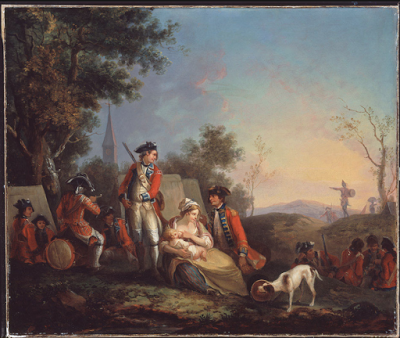The Littlest Camp Followers, c1775
 Susan reporting,
Susan reporting,One of the things I appreciate most about the still-new Museum of the American Revolution in Philadelphia is the way the artifacts, videos, and exhibits are so much more inclusive than many more traditional exhibitions devoted to the Revolution and life in 18thc America. The stories told by the MoAR feature the familiar heroic actors like George Washington, but there are also many other individuals - including Native Americans, African Americans, and women - whose contributions and sacrifices have been too often overlooked, forgotten, or purposefully ignored.
This tiny earthenware lamb (only a few inches long) represents a group that was very much involved in the war, yet seldom mentioned: the children of soldiers. Along with their mothers and soldier-fathers, these children - often born during a campaign - were a familiar feature of 18thc armies. While the term "camp follower" conjured up titillating images like this, the reality was that the majority of the women traveling with the army were married to enlisted men; these women were often employed in laundering, food preparation, and tending the sick and wounded. Their children, of course, had little choice in the matter; they simply "followed the drum" because they followed their fathers.
Children appear in contemporary paintings of military scenes like the one shown here. The reality was likely much more rough-and-tumble, and combined with the real possibilities of danger, disease, and death, yet their presence at the time was unquestioned in a way that seems unfathomable to us today.

The lamb toy was excavated from a British Revolutionary War campsite near New York City, a British stronghold through much of the war. Made in England of white salt-glazed stoneware, the lamb could have crossed the Atlantic on board a troop ship with its owner, or been purchased in a New York shop.
The name of the lamb's young owner isn't known, nor are the circumstances of how it was lost or left behind at the camp. Lost toys are nothing new, nor, sadly, are children in the middle of wars. Still, I hope that both that long-ago child and his or her parents returned safely from the war, even if the lamb remained behind as a poignant reminder of a child in the middle of an adult conflict.
Thanks to Philip Mead, Chief Historian of the Museum of the American Revolution, for suggesting this post.
Left: Toy Lamb, England, 1750-1800, on loan from the New-York Historical Society to the Museum of the American Revolution.
Right: British Infantrymen of a Royal Regiment in an Encampment, painter unknown, c1760, National Army Museum.
Published on November 26, 2017 18:10
No comments have been added yet.



